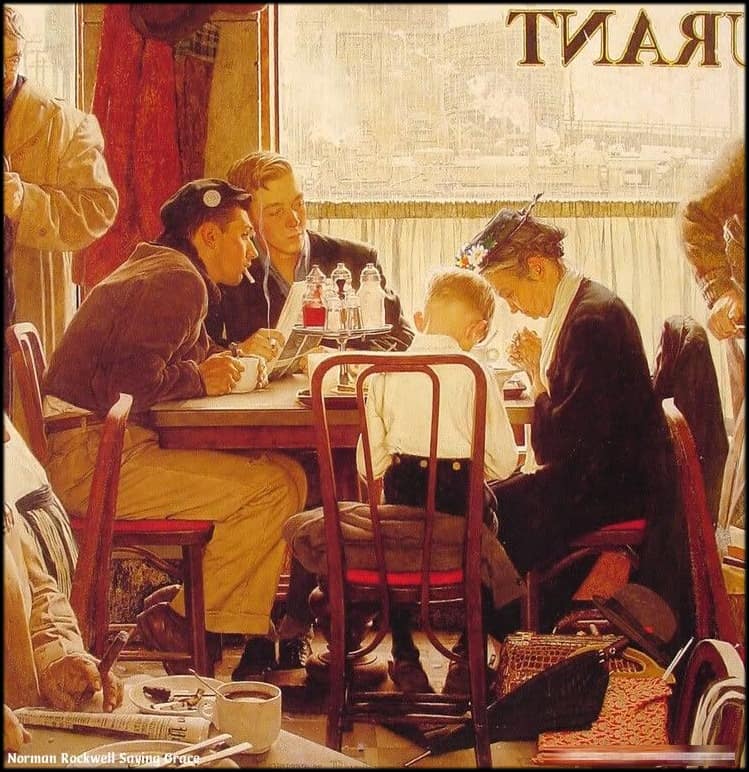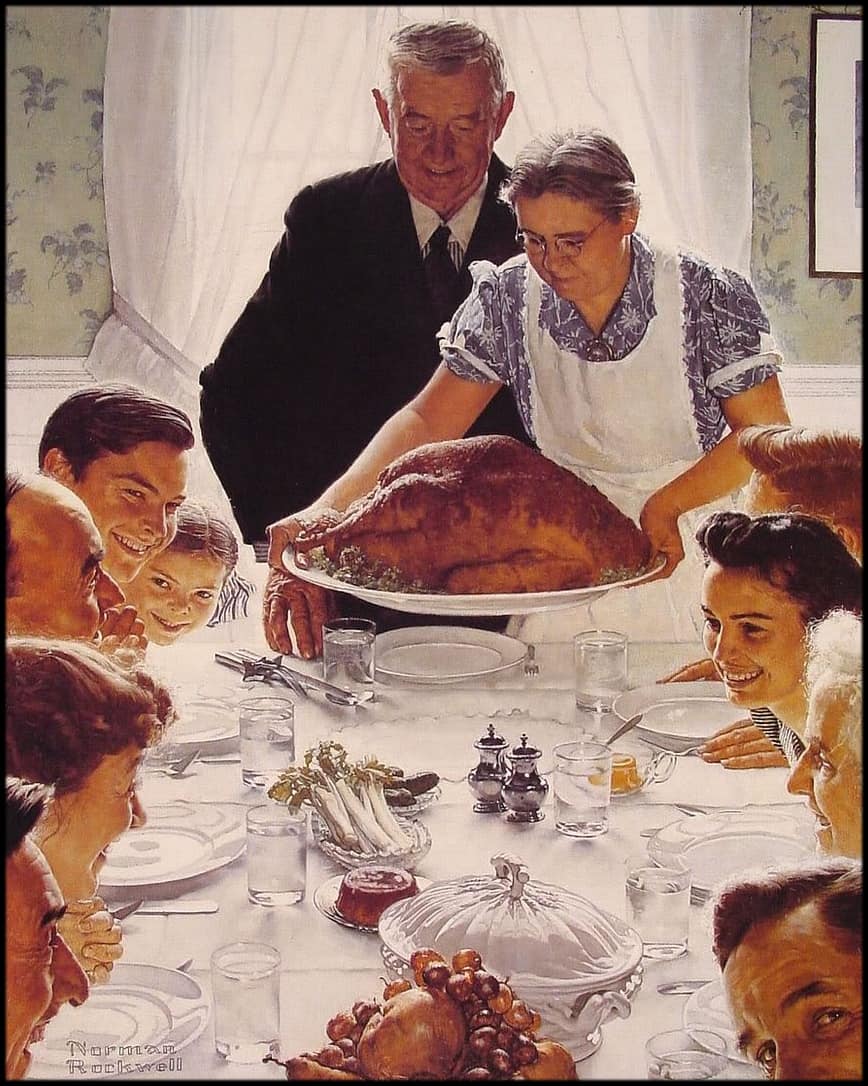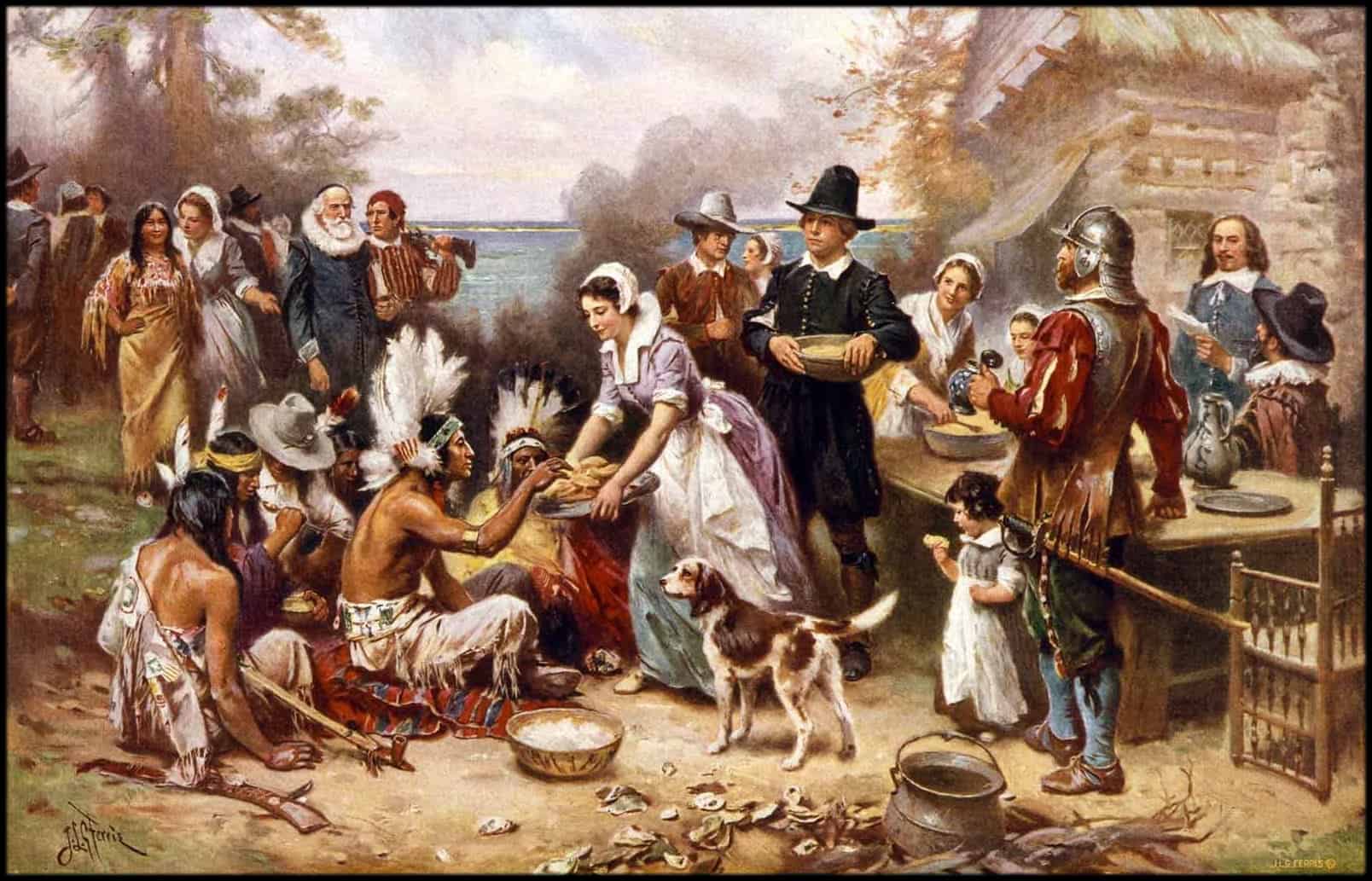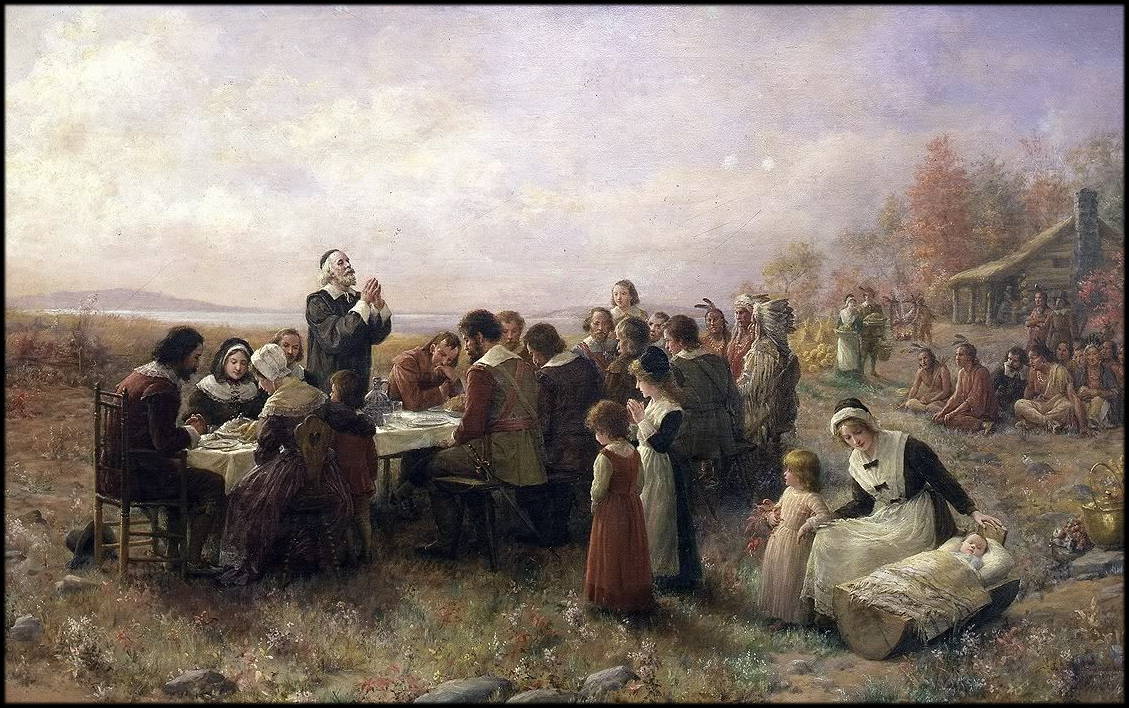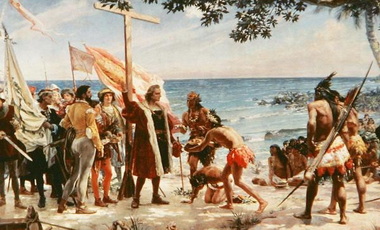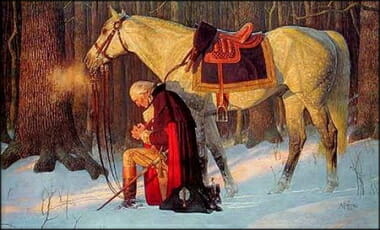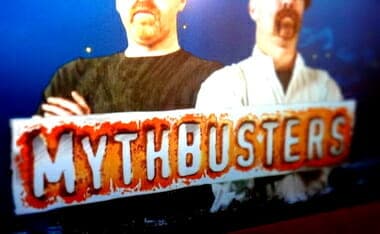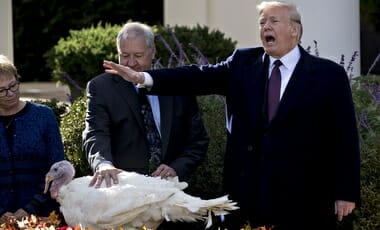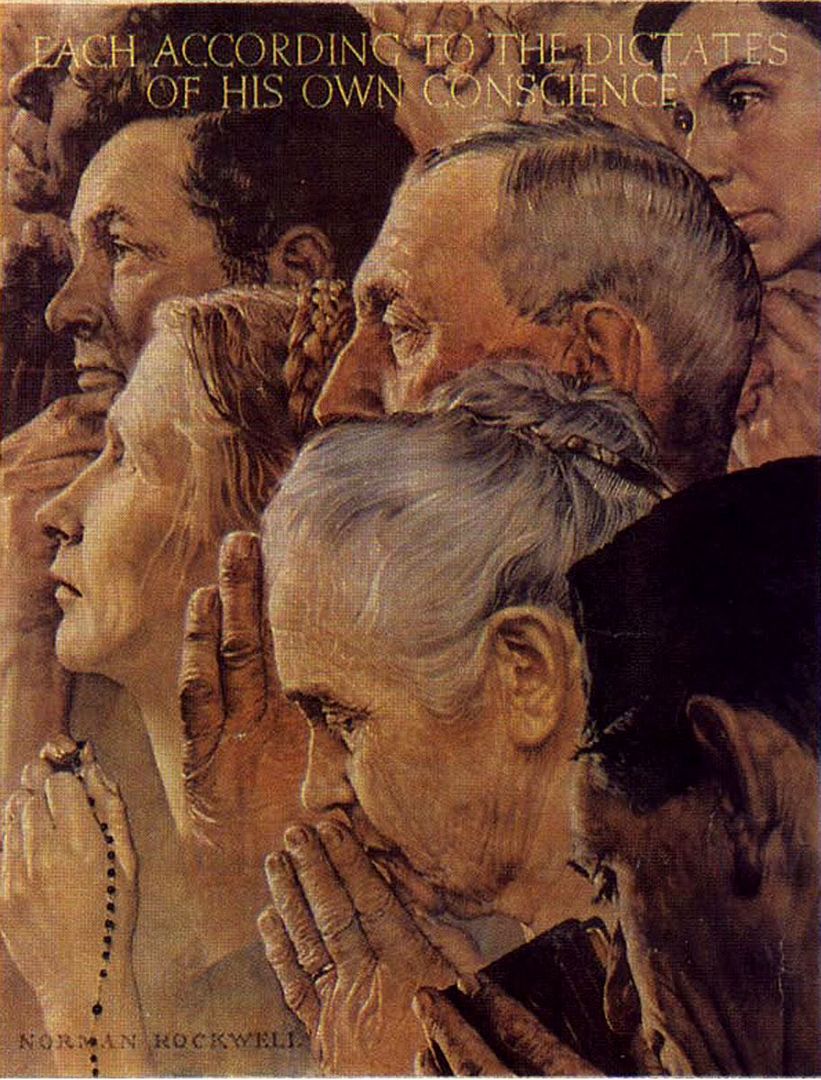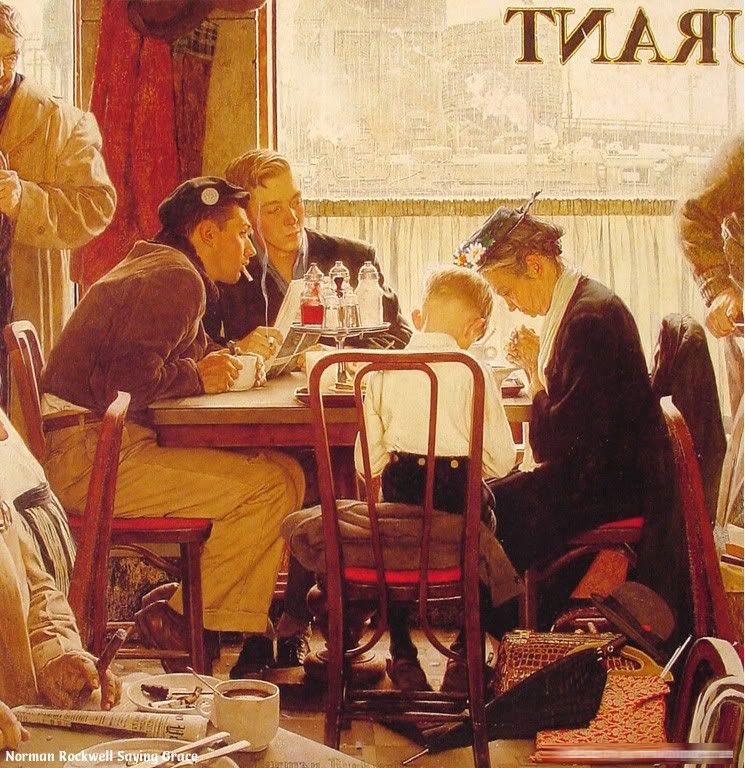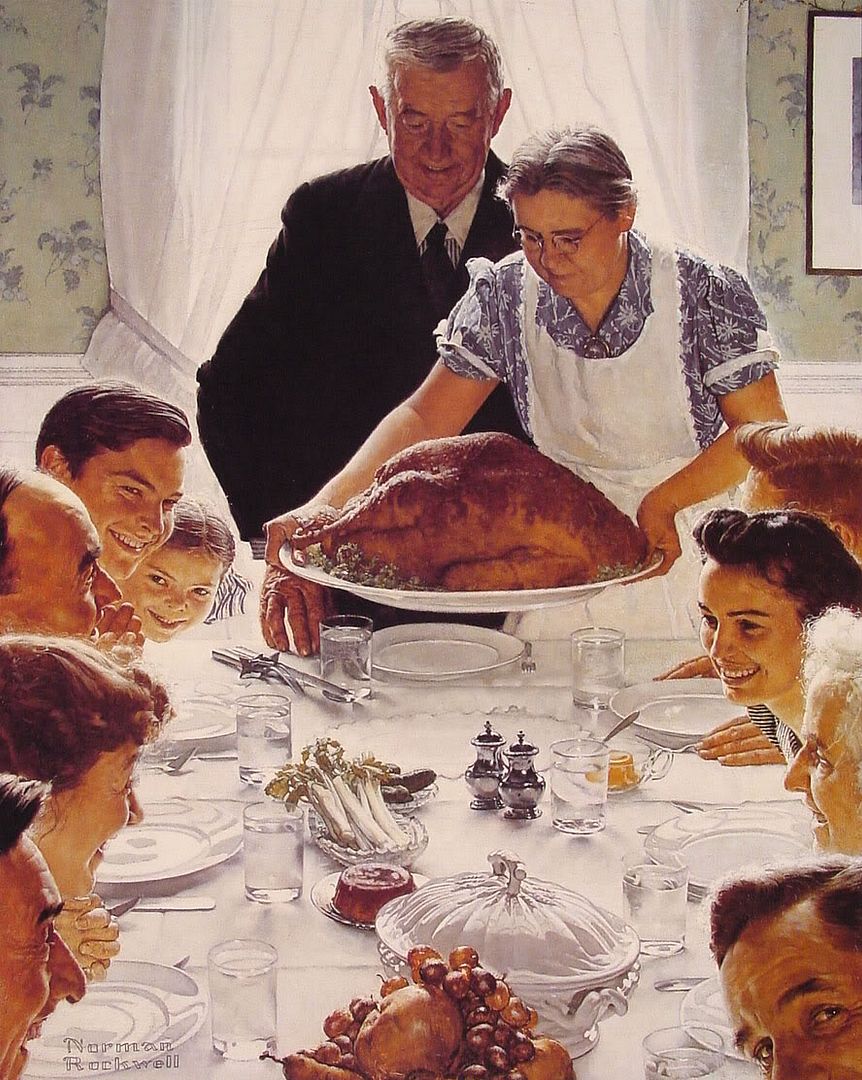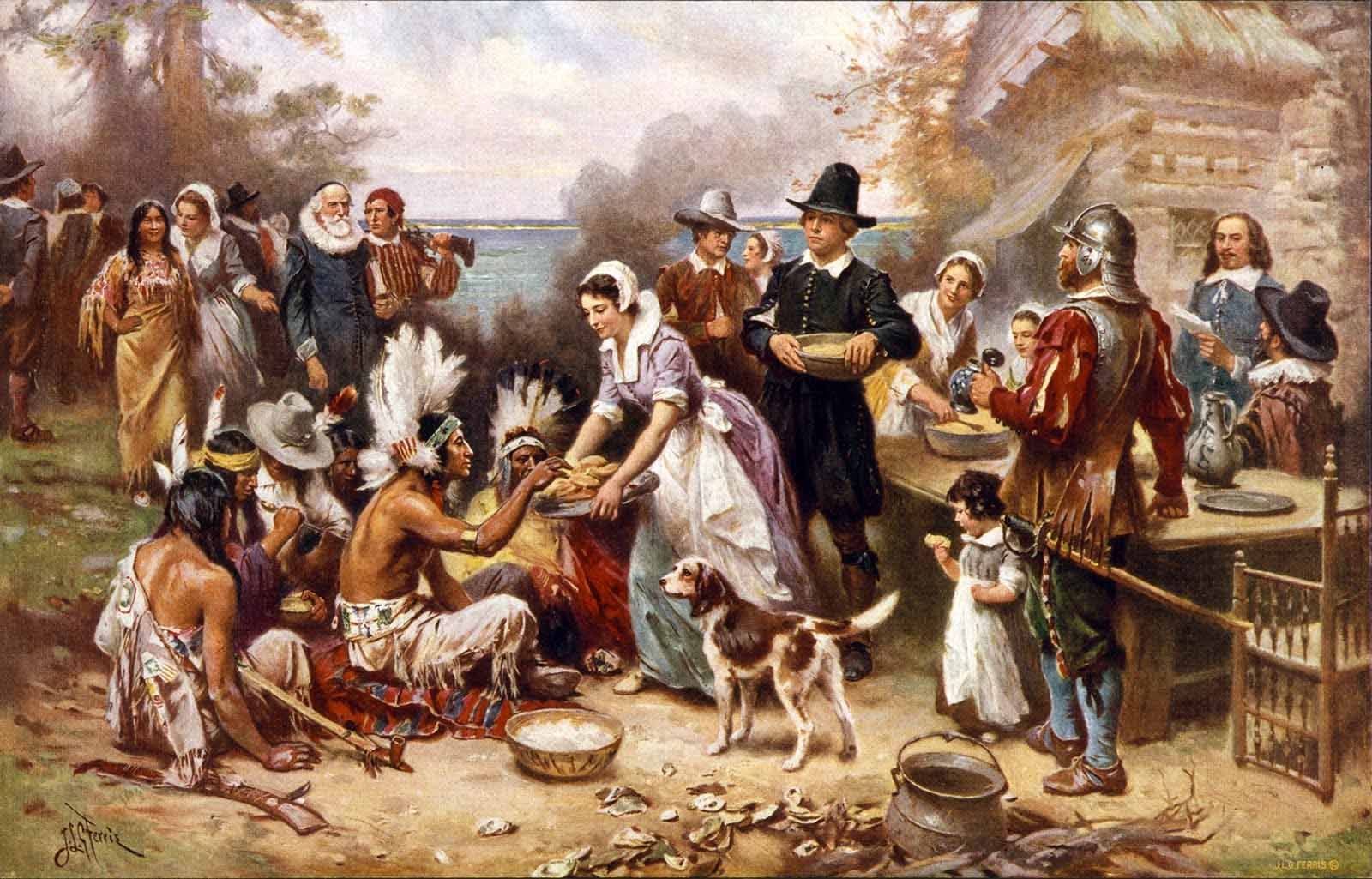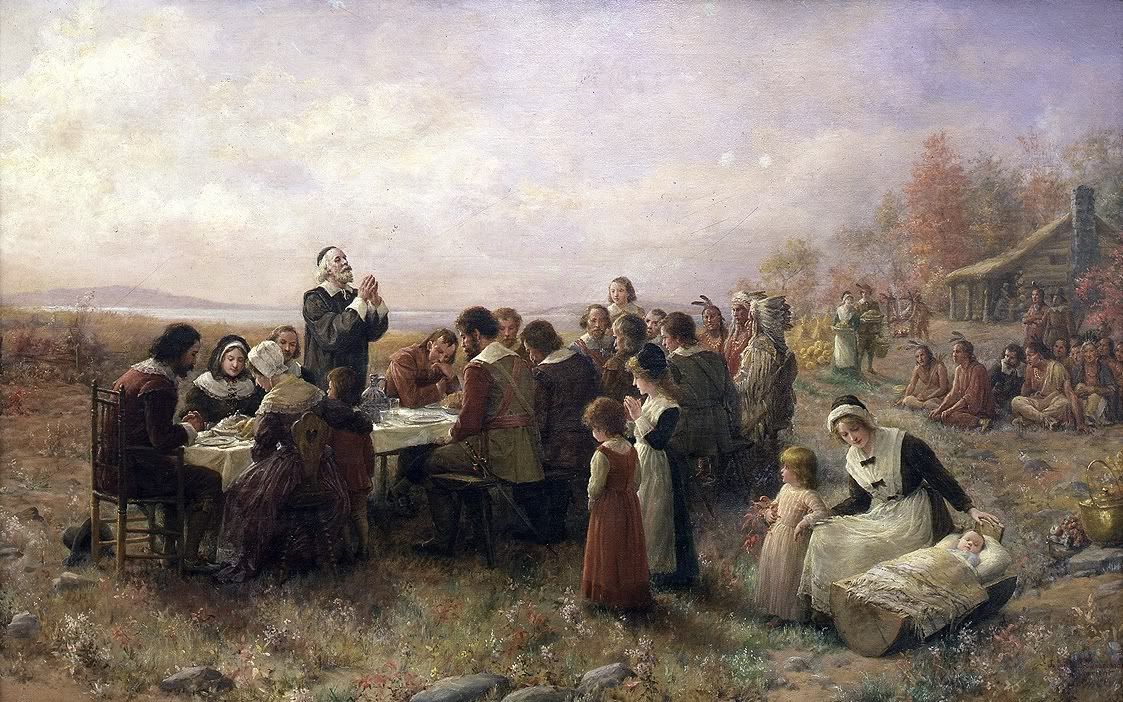My other yearly posts are:
- George Washington’s Thanksgiving Proclamation
- What’s the Truth About the First Thanksgiving?
- Some Turkey Sized Myths About Thanksgiving and America
The art is with thanks to Joyful Heart and their THANKSGIVING page:
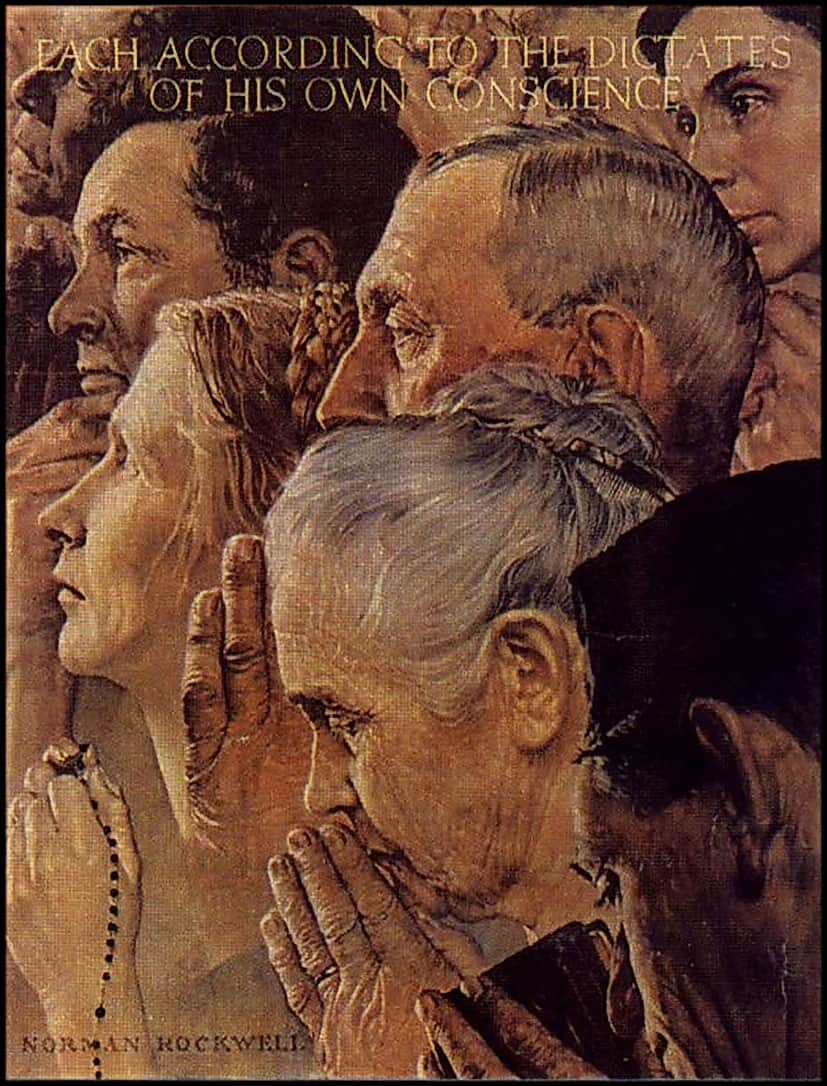
One should note that this is a DISTINCTLY Christian Holiday, via COLD CASE CHRISTIANITY:
….Regardless of how people may feel about the Thanksgiving Holiday, one thing should be obvious to even the most casual observer of history: Thanksgiving was (and still is) founded on the Christian notion we have something to be thankful for and someone to be thankful to. These first observers of Thanksgiving understood who it was they were to thank. Over and over again, through the early years of the colonies to the most difficult days of our national history, believers and leaders have affirmed and humbled themselves to the providence and protection of God. Those who initiated this national holiday intended it to be a day of thanksgiving and prayer; a day in which all of us could offer thanks to the God of the Universe.
This wonderful historical tour by professor Cameron G. Thies adds to the beauty of this historical trip down the US of A’s memory lane (this was originally a LIBERTARIAN REPUBLICAN post, but that blog is no more, sadly):
In 1534, Jacques Cartier of France set off to discover a northwest passage to China. Though encouraged by his discovery of the Gulf of St. Lawrence on his first voyage; and, in a subsequent voyage, his discovery of the St. Lawrence River, he eventually accepted that what he had discovered wasn’t a northwest passage, but was a vast territory inhabited by various tribes of Indians, with a harsh and unforgiving climate. In three voyages, he traded with the Indians, possessing as he did useful things made of metal, that the Indians found to be quite valuable since they had not mastered metal-working. But, because of the harsh winters and Indian raids, the place was less than ideal for colonization.
In 1604, an attempt was made by the French to establish a permanent colony at St. Croix, in present day Maine, on the Bay of Fundy. (The bay is located between Nova Scotia on the east and New Brunswick and Maine on the west.) The site was terrible. The change in altitude from inland to the coast acted like a flue, bringing the freezing cold wind from the northwest down upon the settlement. Half the colony died that winter. The next year, the survivors relocated across the bay, at Port Royal. This became the first permanent European settlement in the Americas north of Florida, following the abandonment or other end of the Viking settlements at the onset of the Little Ice Age.
The first permanent English colony in the Americas north of Florida was established at Jamestown, Virginia, two years later, in 1607. This colony would have failed if not for the assistance of the local Indian tribe, the Powhatan Indians. Even so, the colonists and the Powhatan Indians recurrently warred against each other. To cement the peace treaty ending one of these wars, an Indian princess named Pocahontas married one of the leaders of the colony, John Rolfe. She converted to Christianity and returned with her husband to England where she entered society as a lady. In 1619, the colony organized a representative body, the House of Burgesses, to provide local government.
The Virginia colony had been founded as a joint stock company based on the prospect of discovering gold and diamonds and such. But, as an investment, the company proved to be a complete loss. The king dissolved the corporate charter, and reorganized the colony as with a royal charter. But, eventually the colony began turning a profit with the cultivation of tobacco.
Further to the north, a second permanent English colony was organized in Plymouth Bay, Massachusetts, in 1620. It, like the original location of the French in the Bay of Fundy was unfortunately sited in terms of the local climate. Cape Cod, jutting into the Atlantic Ocean, directed the warming currents of the Gulf Stream eastward, leaving the shores of the bay particularly cold. The first winter proved very harsh, and half the settlers perished. An Indian named Squanto of a local tribe arrived on the scene and helped the survivors with fishing, hunting and planting. The local tribe allied with the colony and became something of a conduit for the exchange of metal tools and such for furs acquired from inland tribes.
The Plymouth Bay colony consisted of religious dissidents, known as Puritans, for whom the Church of England, though a Protestant church, was a backsliding church. Their journey to the New World was a search for an isolated place where their rules would be law. It is possible that their celebration of Thanksgiving was in keeping with the Jewish holiday of Sukkot, an eight-day holiday, that is to culminate in a community-wide dinner. During the week, you are to live outdoors, if this is possible, and eat outdoors, under an open canopy. It is a time to remember the wandering in the desert, when Israel was guided by the Shekinah Glory and God was with his people. It is also a time to anticipate when the Shekinah Glory will return, and when God will again be with his people.
Squanto
The Story of Squanto… WHY the Pilgrims saw God’s providential hand on their lives, and gave thanks to God for this Providence over the course of mankind. Here, Eric Metaxas talks about some of this history in his WALL STREET Journal article (as well as an excellent video by Ben Shapiro):
The story of how the Pilgrims arrived at our shores on the Mayflower—and how a friendly Patuxet native named Squanto showed them how to plant corn, using fish as fertilizer—is well-known. But Squanto’s full story is not, as National Geographic’s new Thanksgiving miniseries, “Saints & Strangers,” shows. That might be because some details of Squanto’s life are in dispute. The important ones are not, however. His story is astonishing, even raising profound questions about God’s role in American history.
Every Thanksgiving we remember that, to escape religious persecution, the Pilgrims sailed to the New World, landing at Plymouth Rock in 1620. But numerous trading ships had visited the area earlier. Around 1608 an English ship dropped anchor off the coast of what is today Plymouth, Mass., ostensibly to trade metal goods for the natives’ beads and pelts. The friendly Patuxets received the crew but soon discovered their dark intentions. A number of the braves were brutally captured, taken to Spain and sold into slavery.
One of them, a young man named Tisquantum, or Squanto, was bought by a group of Catholic friars, who evidently treated him well and freed him, even allowing him to dream of somehow returning to the New World, an almost unimaginable thought at the time. Around 1612, Squanto made his way to London, where he stayed with a man named John Slany and learned his ways and language. In 1618, a ship was found, and in return for serving as an interpreter, Squanto would be given one-way passage back to the New World.
After spending a winter in Newfoundland, the ship made its way down the coast of Maine and Cape Cod, where Squanto at last reached his own shore. After 10 years, Squanto returned to the village where he had been born. But when he arrived, to his unfathomable disappointment, there was no one to greet him. What had happened?
It seems that since he had been away, nearly every member of the Patuxets had perished from disease, perhaps smallpox, brought by European ships. Had Squanto not been kidnapped, he would almost surely have died. But perhaps he didn’t feel lucky to have been spared. Surely, he must have wondered how his extraordinary efforts could amount to this. At first he wandered to another Wampanoag tribe, but they weren’t his people. He was a man without a family or tribe, and eventually lived alone in the woods.
But his story didn’t end there. In the bleak November of 1620, the Mayflower passengers, unable to navigate south to the warmer land of Virginia, decided to settle at Plymouth, the very spot where Squanto had grown up. They had come in search of religious freedom, hoping to found a colony based on Christian principles.
Their journey was very difficult, and their celebrated landing on the frigid shores of Plymouth proved even more so. Forced to sleep in miserably wet and cold conditions, many of them fell gravely ill. Half of them died during that terrible winter. One can imagine how they must have wept and wondered how the God they trusted and followed could lead them to this agonizing pass. They seriously considered returning to Europe.
But one day during that spring of 1621, a Wampanoag walked out of the woods to greet them. Somehow he spoke perfect English. In fact, he had lived in London more recently than they had. And if that weren’t strange enough, he had grown up on the exact land where they had settled.
Because of this, he knew everything about how to survive there; not only how to plant corn and squash, but how to find fish and lobsters and eels and much else. The lone Patuxet survivor had nowhere to go, so the Pilgrims adopted him as one of their own and he lived with them on the land of his childhood.
No one disputes that Squanto’s advent among the Pilgrims changed everything, making it possible for them to stay and thrive. Squanto even helped broker a peace with the local tribes, one that lasted 50 years, a staggering accomplishment considering the troubles settlers would face later.
So the question is: Can all of this have been sheer happenstance, as most versions of the story would have us believe? The Pilgrims hardly thought so. To them, Squanto was a living answer to their tearful prayers, an outrageous miracle of God. Plymouth Colony Governor William Bradford declared in his journal that Squanto “became a special instrument sent of God” who didn’t leave them “till he died.”
Indeed, when Squanto died from a mysterious disease in 1622, Bradford wrote that he wanted “the Governor to pray for him, that he might go to the Englishmen’s God in heaven.” And Squanto bequeathed his possessions to the Pilgrims “as remembrances of his love.”
These are historical facts. May we be forgiven for interpreting them as the answered prayers of a suffering people, and a warm touch at the cold dawn of our history of an Almighty Hand?
Story Time:
On August 1, 1620, the Mayflower set sail. It carried a total of 102 passengers, including forty Pilgrims led by William Bradford. On the journey, Bradford set up an agreement, a contract, that established just and equal laws for all members of the new community, irrespective of their religious beliefs.
Where did the revolutionary ideas expressed in the Mayflower Compact come from? From the Bible. The Pilgrims were a people completely steeped in the lessons of the Old and New Testaments. They looked to the ancient Israelites for their example. And, because of the biblical precedents set forth in Scripture, they never doubted that their experiment would work.
“But this was no pleasure cruise, friends. The journey to the New World was a long and arduous one. And when the Pilgrims landed in New England in November, they found, according to Bradford’s detailed journal, a cold, barren, desolate wilderness,” destined to become the home of the Kennedy family. “There were no friends to greet them, he wrote. There were no houses to shelter them. There were no inns where they could refresh themselves. And the sacrifice they had made for freedom was just beginning.
During the first winter, half the Pilgrims – including Bradford’s own wife – died of either starvation, sickness or exposure.
“When spring finally came, Indians taught the settlers how to plant corn, fish for cod and skin beavers for coats.” Yes, it was Indians that taught the white man how to skin beasts. “Life improved for the Pilgrims, but they did not yet prosper! This is important to understand because this is where modern American history lessons often end. “Thanksgiving is actually explained in some textbooks as a holiday for which the Pilgrims gave thanks to the Indians for saving their lives, rather than as a devout expression of gratitude grounded in the tradition of both the Old and New Testaments.
Here is the part [of Thanksgiving] that has been omitted: The original contract the Pilgrims had entered into with their merchant-sponsors in London called for everything they produced to go into a common store, and each member of the community was entitled to one common share.
“All of the land they cleared and the houses they built belong to the community as well. They were going to distribute it equally. All of the land they cleared and the houses they built belonged to the community as well. Nobody owned anything. They just had a share in it. It was a commune, folks. It was the forerunner to the communes we saw in the ’60s and ’70s out in California – and it was complete with organic vegetables, by the way.
Bradford, who had become the new governor of the colony, recognized that this form of collectivism was as costly and destructive to the Pilgrims as that first harsh winter, which had taken so many lives.
He decided to take bold action. Bradford assigned a plot of land to each family to work and manage, thus turning loose the power of the marketplace.
“That’s right. Long before Karl Marx was even born, the Pilgrims had discovered and experimented with what could only be described as socialism. And what happened?
It didn’t work! Surprise, surprise, huh?
What Bradford and his community found was that the most creative and industrious people had no incentive to work any harder than anyone else, unless they could utilize the power of personal motivation!
But while most of the rest of the world has been experimenting with socialism for well over a hundred years – trying to refine it, perfect it, and re-invent it – the Pilgrims decided early on to scrap it permanently.
What Bradford wrote about this social experiment should be in every schoolchild’s history lesson. If it were, we might prevent much needless suffering in the future.
“‘The experience that we had in this common course and condition, tried sundry years…that by taking away property, and bringing community into a common wealth, would make them happy and flourishing – as if they were wiser than God,’ Bradford wrote. ‘For this community [so far as it was] was found to breed much confusion and discontent, and retard much employment that would have been to their benefit and comfort. For young men that were most able and fit for labor and service did repine that they should spend their time and strength to work for other men’s wives and children without any recompense…that was thought injustice.’
Why should you work for other people when you can’t work for yourself? What’s the point?
“Do you hear what he was saying, ladies and gentlemen? The Pilgrims found that people could not be expected to do their best work without incentive. So what did Bradford’s community try next? They unharnessed the power of good old free enterprise by invoking the undergirding capitalistic principle of private property.
Every family was assigned its own plot of land to work and permitted to market its own crops and products. And what was the result?
‘This had very good success,’ wrote Bradford, ‘for it made all hands industrious, so as much more corn was planted than otherwise would have been.’
Bradford doesn’t sound like much of a… liberal Democrat, “does he? Is it possible that supply-side economics could have existed before the 1980s? Yes.
“Read the story of Joseph and Pharaoh in Genesis 41. Following Joseph’s suggestion (Gen 41:34), Pharaoh reduced the tax on Egyptians to 20% during the ‘seven years of plenty’ and the ‘Earth brought forth in heaps.’ (Gen. 41:47)
In no time, the Pilgrims found they had more food than they could eat themselves…. So they set up trading posts and exchanged goods with the Indians. The profits allowed them to pay off their debts to the merchants in London.
And the success and prosperity of the Plymouth settlement attracted more Europeans and began what came to be known as the ‘Great Puritan Migration.'”
Now, other than on this program every year, have you heard this story before? Is this lesson being taught to your kids today — and if it isn’t, why not? Can you think of a more important lesson one could derive from the pilgrim experience?
So in essence there was, thanks to the Indians, because they taught us how to skin beavers and how to plant corn when we arrived, but the real Thanksgiving was thanking the Lord for guidance and plenty — and once they reformed their system and got rid of the communal bottle and started what was essentially free market capitalism, they produced more than they could possibly consume, and they invited the Indians to dinner, and voila, we got Thanksgiving, and that’s what it was: inviting the Indians to dinner and giving thanks for all the plenty is the true story of Thanksgiving.
The last two-thirds of this story simply are not told.
Now, I was just talking about the plenty of this country and how I’m awed by it. You can go to places where there are famines, and we usually get the story, “Well, look it, there are deserts, well, look it, Africa, I mean there’s no water and nothing but sand and so forth.”
It’s not the answer, folks. Those people don’t have a prayer because they have no incentive. They live under tyrannical dictatorships and governments.
The problem with the world is not too few resources. The problem with the world is an insufficient distribution of capitalism. [1]
[1] Rush Limbaugh, See, I Told You So! page 70.
One should see my stuff on the topics as well:
- Native American History In Public School (Howard Zinn Refuted)
- Johnny Depp & Disney vs. History (h/t ~ Brad Thor);
- Mayan and Aztec “Terrorism” Vs. Christopher Columbus
- Did Europe Destroy Native American Culture?
- A Rebuttal Of The Lefts View of Columbus and the New World;
- Trail of Tears, Death Toll Myths Dispelled (This is a link elsewhere, to which the following is the main premise):
- (Editor’s note: A recent federal bill memorializing as a National Historic Trail what has come to be known as the Cherokee Indian Trail of Tears is based on false history, argues William R. Higginbotham. In this article, the Texas-based writer delves into the historic record and concludes that about 840 Indians not the 4,000 figure commonly accepted died in the 1837-38 trek west; that the government-financed march was conducted by the Indians themselves; and that the phrase “Trail of Tears” was a label that was added 70 years later under questionable circumstances.) The problem with some of our accounts of history is that they have been manipulated to fit conclusions not borne out by facts. Nothing could be more intellectually dishonest. This is about a vivid case in point.
Happens every Thanksgiving, doesn’t? Some bleeding heart liberal you’re “related to” gets on their moral high Crazy Horse and lectures about how horribly rotten the white man was to the Native Americans. Which is why this year we’re throwing in the tomahawk. Time to scalp the facts about the Indians. Feathers not dots….
MYTH: THE NATIVE AMERICANS WERE A PEACEFUL CULTURE TO WHOM THE CONCEPT OF WAR WAS FOREIGN
FACT: MANY WERE BRUTAL, CONQUERING ***HOLES
Native Americans warred with each other since, forever. Sometimes it was over hunting or farming grounds, sometimes revenge, sometimes to steal, sometimes to kill. I don’t say this to demonize them, they were no different than any other regressive, Neolithic cultures on other continents.
But the truth is that the only way settlers were able to conquer this land was through the help of Native Americans who teamed up with them to settle the score with the other, more assholish tribes. You think Cortes was able to conquer with only 500 Conquisadors. Course not, it took 50,000 ANGRY allied Native Americans who’d had it up to here with being enslaved and forced to carry gold for the other, Native Aztecs.
Some of of the Indian tribes were the most brutal in existence.
They practiced enslavement, rape, cannibalism, would sometimes target women and children, tribes like the Commanchees would butcher babies and roast people alive… and by the way, where do you think we LEARNED scalping?
MYTH: NATIVE AMERICANS WERE AN ADVANCED SOCIETY
TRUTH: NOT EVEN CLOSE
Smell that? It’s your sacred cow being torched. After I scalped her, of course. Unlike Rome, Greece, China, or pretty much any great empire which had already existed at that time, the Native Americans didn’t have advanced plumbing, transportation, mathematics or really… anything that led to the iphone on which you’re currently watching this. That whole beautiful “horseback Indian” culture you read about? It’s a lie because they hadn’t even domesticated horses. Not only that, but they didn’t even use the WHEEL. No really. 1400 AD… no wheel.
Even more reason that, when you’re that far behind, the clash of civilizations is going to be THAT much more drastic when the new wheel-using world catches up to you.
MYTH: THE SETTLERS DELIBERATELY INFECTED NATIVES WITH SMALLPOX BLANKETS TO WHIPE THEM OUT
TRUTH: ONLY IDIOTS COULD POSSIBLY BELIEVE THIS
Think about it. You really believe Europeans waged microbial, biological warfare… long before discovery, mass acceptance or even close to an understanding of advanced germ theory?
So it’s not true. You can look forever for historical accounts of mass smallpox blankets being pajamagrammed to the peaceful Indians, but you won’t find them. But there is SOME truth to the myth, which brings us to our final point.
MYTH: EUROPEANS COMMITTED MASS GENOCIDE. KILLING EVERY NATIVE AMERICAN FOR SPORT
TRUTH: NOT EVEN CLOSE
However, it is estimated that at high as 95% of pre-Columbian Native Americans were in fact killed off by disease, WHY? Because Europeans introduced new diseases to which the Native Americans hadn’t developed an immunity not only with THEMSELVES but now contact with animals like again HORSES which Native Americans hadn’t domesticated. Again, because they were such an archaic, unadvanced society.
Sure there were plenty of bloody, horrendous, unimaginable battles that occurred, and generally when it comes to neoloithic tribes and more advances settlers, the guys with the boom-boom sticks win. This isn’t exclusive to America or all that uncommon.
But Europeans were not hellbent on wiping out Native Americans, they were actually encouraged to bring the people into European culture and convert them to Christianity. Plus, inter-marrying was incredibly common. How else do you explain Johnny Depp, Angalina Jolie, Kid Cudi and even imaginary Elizabeth Warren claiming to be 1/16th Cherokee?
Killing people is bad. But so is milking, misleading and guilting all future generations for crimes they didn’t commit. Yep, Europeans conquered the Native Americans, created a Constitutional Republic, and advanced in mere centuries what Natives couldn’t do for thousands of years here on the plot of land that is America. So close this smartphone window, go enjoy your turkey and tell your social justice warrior cousin at the table to shut that mustached, single-origin-coffee drinking-hole. Or just… hand him a smallpox napkin.
SOURCES
- Indigenous Americans didn’t invent the wheel: QUORA
- Native Americans were introduced to horses by Spaniards: SCIENCE NEWS
- Smallpox blanket hoax: UNIVERSITY OF MICHIGAN
- Time table of Native American wars: U-S-HISTORY
- Easy to read reference guide of conflicts from 1540 on: LEGENDS OF AMERICA
- Details of Colonial Indian wars: LEGENDS OF AMERICA
- Clashes with European settlers: WEST VIRGINIA ARCHIVES & HISTORY
- Comanches butchered babies, ate enemies: DAILY MAIL
- Capitalism over cannibalism: THE BLAZE
- Reject the lie of white “genocide” against Native Americans: FREE REPUBLIC
- Native Americans “National Day of Mourning”: UNITED AMERICAN INDIANS OF NEW ENGLAND
- Obama’s Thanksgiving messages regularly fail to actually thank God: BREITBART
- 8 little known Thanksgiving facts: THE BLAZE
- Top 5 Thanksgiving proclamations: THE BLAZE
Read more: http://louderwithcrowder.com/thanksgiving-truth-about-native-americans/#ixzz3sigd2v9t
Follow us: @scrowder on Twitter | stevencrowderofficial on Facebook
BONUS ARTICLES:
- Our Rebel Thanksgiving (AMERICAN CONSERVATIVE)
- A Typical US Worker Will Earn Enough This Morning to Pay for a Thanksgiving Banquet (FEE)
- Thanksgiving and America (IMPRIMIS)
- The other capitalist Thanksgiving story: How trade saved the Pilgrims, and the U.S. (ACTON INSTITUTE)

